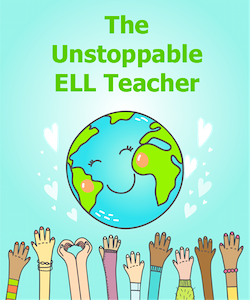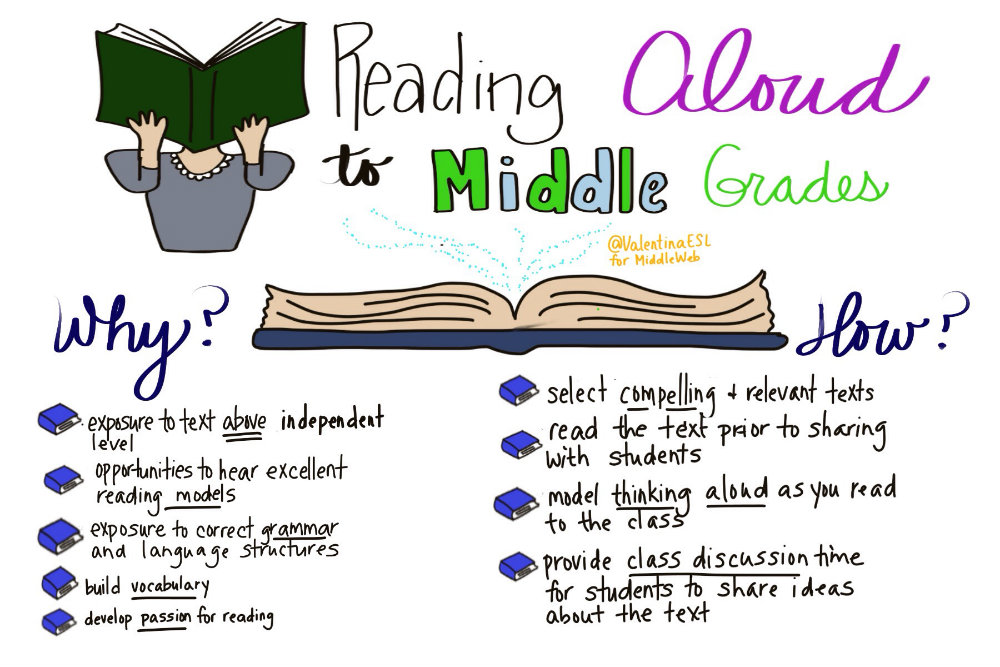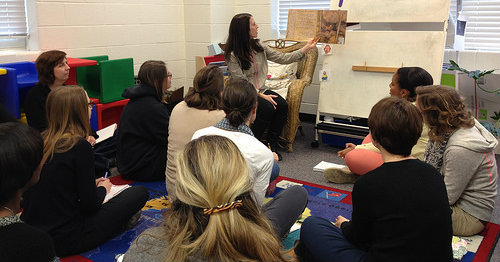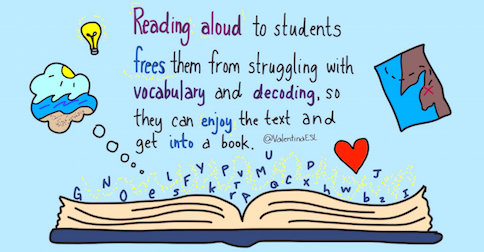Read Alouds Are Great for the Middle Grades!
A MiddleWeb Blog
 We might think that read alouds are only for primary students. We have this idea that our older kids won’t enjoy being read to or they won’t benefit from a learning experience we usually associate with “little kids.”
We might think that read alouds are only for primary students. We have this idea that our older kids won’t enjoy being read to or they won’t benefit from a learning experience we usually associate with “little kids.”
But reading aloud is actually an excellent strategy for all the students in our middle grades classrooms.
By definition, a read aloud is the practice of reading a text aloud to students. The text can be of various lengths and genres (a book, a chapter, a poem, fiction or nonfiction). While students do not have to have a copy of the text, some English Language Learners benefit from following along.
Why it’s worth your time
Read alouds allow students exposure to text that is above their independent reading level. They may not be able to read the text on their own, but when we read the text aloud to our students, they are able to think about the information at a higher level, without having to constantly try to pick out the meaning of certain words.
For an ELL, this is amazing. Think about an ELL in grades 4-8 who is not able to read at grade level yet but can think and analyze at grade level. This opportunity is empowering!
Read alouds also provide our students with opportunities to hear excellent reading models. When we as teachers read aloud, we model fluency and expression. ELLs need to hear great models of English language.
Read alouds offer students exposure to correct grammar, pronunciation, and language structures. Jim Trelease says in his The Read Aloud Handbook that “grammar is more caught than taught, much like you catch the flu.” He says you’re exposed to it. The more we expose our students to correct grammar, the more they will catch how to use it themselves.
If we want our students to learn new vocabulary, Trelease says there are only two efficient ways to do this: either by seeing the words or by hearing them. For ELLs, read alouds offer a way to hear many new vocabulary words while the teacher is there to support meaning with comprehensible input.
Reading aloud to our students also helps them link reading with pleasure and allows them an opportunity to “get inside a book.” This experience helps young readers develop into lifelong readers that are passionate about reading.
How to choose read alouds
In my opinion, the best books and articles for read alouds are compelling and relevant to the students we teach. So get to know your kids and what they like. That will help you pick a great read aloud book for them. If you want to captivate your audience, and middle grade students are a tough group to impress, you will want to be very picky about the texts you select to read aloud.
The book can be a chapter book, a picture book (yes, middle grades students love these too), a fiction book, nonfiction. It’s up to you and your students. I suggest starting with a picture book that is grade level appropriate. Another tip is to vary the types of books you read aloud. This will help students to see and hear different genres read by an expert reader…YOU!
Sometimes starting small and building stamina with students helps. If students, especially in the middle grades, are not used to being read to, they may need to grow their “read-aloud listening skills.” Start with a page or two, perhaps move towards a chapter. Poems are nice options as well since they are typically shorter than articles or book chapters.
Always, always read the book ahead of time. Be prepared. If it’s a chapter book, you can read a chapter ahead. This helps you to plan some higher order questions and simply prepares you read the book with better quality in front of your students.
As you read, model what you are thinking as a reader. Stop at critical points and describe some of your process for thinking.
For example, while reading a book you might stop and say, “I’m noticing that the character is beginning to change. In the beginning of the book he was weak and shy. But now, he seems to be stronger. This part right here where he stands up for himself makes me think he is changing.” (Pick these times strategically so you don’t lose your students’ engagement with the text with too much interruption.)
Provide the class with time to discuss the read aloud. It’s important that students talk with their peers about the text. Sharing ideas with one another about a common book – weighing in with their thoughts and opinions – builds community. It’s especially effective if the text is about social issues that affect them such as bullying and peer pressure.
Read with expression. Change your tone as necessary, in sync with the dialogue and punctuation. Pay close attention to how quickly you are reading. Students need time to build mental images of what you are reading. English learners will particularly need time to process what they are hearing.
To make your read aloud extra supportive for ELLs, make it more interactive. Build in time for students to turn and talk with a partner or group. Or have opportunities for students to act out a feeling, draw what they are thinking, or journal a thought related to the reading.
Resources for Reading Aloud to Middle Graders
One of my favorite books that Stephen Krashen recommends is The Read Aloud Handbook by Jim Trelease. It’s excellent, inexpensive and includes a list of read alouds for students of all ages.
The Book Whisperer by Donalyn Miller is another fantastic reading resource.
And The Fountas & Pinnell Literacy Continuum offers great advice for implementing read alouds in a balanced literacy classroom.






































Hi from another Valentina,
I was attracted to your article since I’m also a big proponent of Read Alouds for ELLs and my specialty is ESL/Bilingual. I wonder if we have met. I used to be a trainer for Region 4 but took a hiatus from work to help with mom’s situation. I am back in the job market and just applied to Katy ISD since I live close by. It’d be interesting to meet. Let me hear back from you if possible. Best of luck with your endeavors! It’s a great blog!
Hi Valentina,
Great to hear from you! I’m not sure that we have met before, but I’m hopeful that we will. Thank you for reading and for the feedback!
Nice to hear back from you. Hope we can meet one of these days. Have a great holiday season!
I am listening to a recording of the book The War That Saved My Life. A mid school teacher I know suggested that book as a good read aloud. It is a fantastic book and I highly recommend it for teens and adults too.